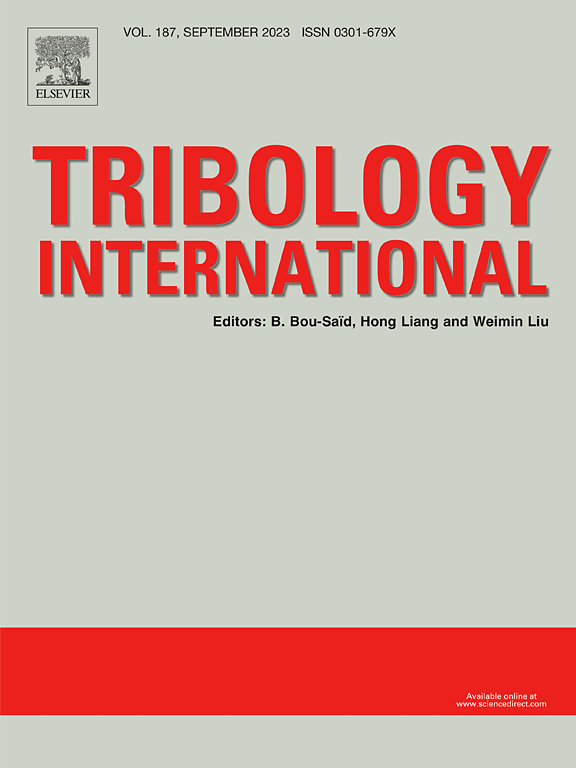Superlubric sliding in a multi-contact fullerene-molybdenum disulfide heterostructure
IF 6.1
1区 工程技术
Q1 ENGINEERING, MECHANICAL
引用次数: 0
Abstract
Recent research shows that superlubric 2D materials offer great potential for friction reduction, yet their requirements of flatness and small scale hinder real-world applications. Here, we study a multi-contact van der Waals heterostructure, composed of fullerene (C60) molecules sandwiched between molybdenum disulfide (MoS2) atomic layers by molecular-dynamics simulations. We show that despite the multi-contact geometry, the confined layer of C60 nanoparticles exhibits superlubric behavior at high fullerene density or high applied normal force, where the fullerenes’ rotational degrees of freedom are suppressed and the MoS2 layer slides over the fullerenes. At lower fullerene density or load, fullerene rolling leads to increased frictional dissipation. We demonstrate that the atomic stacking at the fullerene-MoS2 contact evolves from aligned into misaligned with increasing fullerene coverage, reflecting the increasing fullerene-fullerene interactions suppressing their rolling degrees of freedom. Thus, counterintuitively, in the fullerene-MoS2 heterojunction system, rolling of the fullerenes is not beneficial for friction reduction, as superlubric slip offers an alternative, lower-friction mechanism. These results on the multi-contact sliding of a heterojunction of fullerene nanoparticles and 2D material are useful for guiding nanoscale superlubric properties into macroscopic scale superlubric applications.
多接触富勒烯-二硫化钼异质结构中的超润滑剂滑动
最近的研究表明,超润滑二维材料在减少摩擦方面具有巨大的潜力,但它们对平面度和小尺寸的要求阻碍了实际应用。本文通过分子动力学模拟研究了夹在二硫化钼(MoS2)原子层之间的富勒烯(C60)分子构成的多接触范德华异质结构。我们发现,尽管C60纳米颗粒具有多接触几何结构,但在高富勒烯密度或高法向力作用下,C60纳米颗粒的约束层表现出超润滑行为,在这种情况下,富勒烯的旋转自由度被抑制,MoS2层在富勒烯上滑动。在较低的富勒烯密度或负载下,富勒烯滚动导致摩擦耗散增加。我们证明了随着富勒烯覆盖范围的增加,富勒烯- mos2接触处的原子堆叠从排列演变为不排列,反映了富勒烯-富勒烯相互作用的增加抑制了它们的滚动自由度。因此,与直觉相反,在富勒烯-二硫化钼异质结体系中,富勒烯的滚动不利于减少摩擦,因为超润滑滑移提供了一种替代的低摩擦机制。这些关于富勒烯纳米颗粒与二维材料异质结的多接触滑动的研究结果,对于指导纳米级超润滑剂性能向宏观级超润滑剂的应用具有重要意义。
本文章由计算机程序翻译,如有差异,请以英文原文为准。
求助全文
约1分钟内获得全文
求助全文
来源期刊

Tribology International
工程技术-工程:机械
CiteScore
10.10
自引率
16.10%
发文量
627
审稿时长
35 days
期刊介绍:
Tribology is the science of rubbing surfaces and contributes to every facet of our everyday life, from live cell friction to engine lubrication and seismology. As such tribology is truly multidisciplinary and this extraordinary breadth of scientific interest is reflected in the scope of Tribology International.
Tribology International seeks to publish original research papers of the highest scientific quality to provide an archival resource for scientists from all backgrounds. Written contributions are invited reporting experimental and modelling studies both in established areas of tribology and emerging fields. Scientific topics include the physics or chemistry of tribo-surfaces, bio-tribology, surface engineering and materials, contact mechanics, nano-tribology, lubricants and hydrodynamic lubrication.
 求助内容:
求助内容: 应助结果提醒方式:
应助结果提醒方式:


